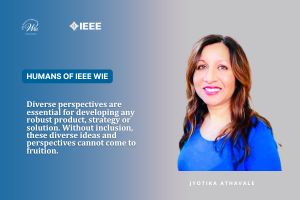Humans of IEEE WIE highlights a dedicated WIE volunteer who is well known for his/her notable contribution to IEEE WIE.
IEEE WIE: Please give us a brief introduction about yourself and your family.
Hi! I grew up in Mumbai, India and then moved to the US for my graduate program in Electrical Engineering. My parents are originally from Jalandhar, Punjab. I have an older sister who also lives in the United States. I met my husband in college and we got married soon after we graduated. We have 3 children – my daughter is a software engineer, my older son is an undergraduate student in computer science, and my younger son is a high-schooler. I’ve worked in the semiconductor industry for over 25 years at various companies including Intel, Nvidia and now at Synopsys. A passionate IEEE volunteer, I now serve as the 2024 President of the IEEE Computer Society, and I am active in technology standardization activities.
I’m also a proud member of IEEE WIE, and have served as the Computer Society liaison to WIE. Last year, I chaired the IEEE WIE awards and recognition Committee, and this year I am excited to take on the role as chair of IEEE WIE ILC Chair 2025-26. I’ve been honored to be named the recipient of the 2024 IEEE Women in Technology leadership award, for commitment to the engineering profession and the advancement of women in STEM. I’m deeply passionate about empowering, supporting and inspiring women in engineering disciplines.
IEEE WIE: What is your specific area of STEM?
I started my career in Electronic Design Automation, and then transitioned into Semiconductor hardware after joining Intel. I spent 20 years at Intel working on Reliability modeling and architecture, soft errors and functional safety architecture for automotive and avionics systems. Later, I moved to Nvidia, where I continued my journey in functional safety, and now at Synopsys I am working on RAS (Reliability Availability and Serviceability) and SLM (Silicon Lifecycle Management) for Data Centers and Automotive systems. At IEEE, I am driving standardization initiatives and new conferences in the areas of functional safety and RAS.
IEEE WIE: Please tell us something interesting about your life that may be why you chose the STEM field.
Growing up, I had a natural inclination for math and science – so when I was in middle school, I decided that I want to be an engineer. My Dad was my role model– I was always in awe of his academic skills. My mom provided strong support and guidance. I felt very fortunate that I was able to secure the opportunity to pursue the career of my dreams. I knew it was new territory because there weren’t any engineers in my immediate family – however I felt confident that it was the right path for me.
IEEE WIE: As an empowered woman, please share how you plan to empower other women. How do you encourage them to take leadership positions?
I believe in the power of mentoring. I’ve mentored other women throughout my career and it’s been very fulfilling to watch my mentees grow and achieve their goals. Providing a platform and support system for women to feel empowered and confident is important. I took on the role of chairing the IEEE WIE International Leadership Conference towards this mission. In the Computer Society we are driving initiatives via the Diversity and Inclusion Committee to support and empower technical women and help them advance in their careers.
IEEE WIE: How do you think diversity and inclusion help in boosting creativity and better problem-solving strategies?
In functional safety – implementing diverse architectures is one of the key approaches to build a resilient system, and reduce common cause failures. Similarly, diverse perspectives are essential for developing any robust product, strategy or solution. Without inclusion, these diverse ideas and perspectives cannot come to fruition.
IEEE WIE: In your opinion, how can everyone ensure that technological advancements are used for the betterment of humanity?
We need to proactively influence the direction of how technological advancements are deployed and ensure that they are steered towards positive outcomes. Technology is powerful, however it needs to be regulated to ensure safety and privacy of all. And we should collectively support advancements for applications that are beneficial for humanity. As leaders in the IEEE community, we have a voice to influence this direction and we should empower our membership to do the same.
IEEE WIE: What is one piece of advice you can give to young professionals who are IEEE WIE members?
I would encourage them to be a change agent. To be empowered to influence and drive positive change around them. Courage and confidence will give you the power to face challenges.
Dream big, and do something wonderful.
IEEE WIE: How do you challenge the status quo or how do you identify problems in your field and propose solutions to bring positive changes?
It is important to speak up for what you believe in, and use data as evidence of proposed solutions for problems that you may encounter. Make a plan, and gather the data and facts to support your proposal. It’s not easy, but you will win eventually if you are the change you wish to see in the world.
IEEE WIE: An empathetic leader helps promote a better work environment. Would you agree?
Yes, empathy is an important quality in leadership. When a leader displays empathy, teams feel loved and motivated to put in their best effort. Empathy helps to build trust and belonging in the workplace.



